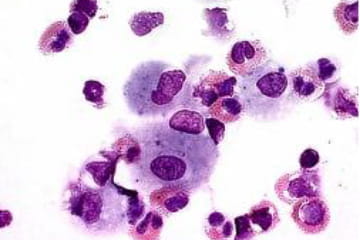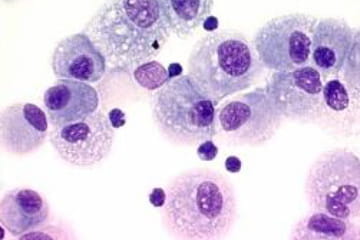This CLIA-certified laboratory provides analysis of bronchoalveolar lavage cells through performance of differential counts, lymphocyte phenotyping, hemosiderin staining for assessment of alveolar hemorrhage and screening for histiocytosis X. The lab is located on Indiana University School of Medicine’s Indianapolis campus in Walther Hall.
Specimen Processing Hours
Bronchoalveolar Lavage specimens are processed Monday through Friday (8 am to 5 pm). Bronchoalveolar Lavage specimens can be received after 8 am and no later than 4 pm. Specimens are not received or processed by the Bronchoalveolar Lavage Laboratory Saturday or Sunday. The Bronchoalveolar Lavage Laboratory does not accept specimens that are more than 18 hours old.
Individuals interested in analysis from the Bronchoalveolar Lavage Laboratoryshould notify the lab as soon as possible about a scheduled specimen, preferably providing at least 24 hours notice. Bronchoalveolar Lavage Laboratory specimens are not processed on observed Federal holidays or the Monday following a weekend holiday. Questions about scheduling and availability can be directed to the Pulmonary Medicine Office at 317-278-2253.
Protocol for Bronchoalveolar Lavage
Although there is no standardized way to perform bronchoalveolar lavage, this lab has extensive experience and validation of the following protocol:
- Bronchoalveolar lavage is performed prior to any biopsies, brushes or manipulations of the airway.
- The bronchoscope is wedged into a subsegment of the middle lobe, anterior segment of a lower lobe or the most affected area. The suction is turned down to prevent collapse of the airways during suctioning. Typically, this is between 40-80 psi (green on the low wall suction pressure indicator).
- The trap is changed to a fresh, clean trap.
- Three (3) 50cc aliquots of either saline or Plasmalyte are used.
- After each 50 cc is instilled, the lab waits a few seconds to dwell and apply constant suction for several seconds (20 seconds typically) until return of the frothy surfactant-rich fluid stops. The next aliquot is instilled and suction applied, repeat for all three aliquots.
- Once all fluid is collected, the trap is removed and put to the side, preferably on ice. The trash trap or hook up directly to the wall suction is then reapplied and bronchoscopy is performed as needed for biopsies and other procedures.
- At no time is the bronchoalveolar lavage fluid added to bronchial washings or “trash trap” (is fine for cytology, but not this lab). The bronchoalveolar lavage is then sent this lab on ice by courier.
- Although return on bronchoalveolar lavage is quite variable (usually 40-60 percent of volume instilled), the lab ideally should receive 30 cc of fluid. The remainder of the fluid could go to cytology or microbiology for culture.
- Sending less than 15 cc of bronchoalveolar lavage fluid is not recommended due to inability to validate the results with the low number of cells in this amount of fluid.
- This lab processes the specimen to optimize cell differentials and perform T cell subtyping and other special phenotypic stains. This processing is performed exclusively for evaluation of interstitial and immunologic lung diseases when they are high on the differential. Sample should also be sent to cytology or microbiology as deemed clinically appropriate.
Instructions to Clients
These instructions are for all physicians, clerical, nursing, laboratory or other staff involved in the preservation, transportation and/or collection of bronchoalveolar lavage specimens:



